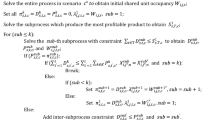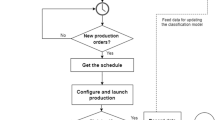Abstract
In this research, minimizing the expected number of tardy jobs in a dynamic m machine flow-shop scheduling problem, i.e., \( {F_m}\left| {{r_j}\left| {{\text{E}}\left[ {\sum {{U_j}} } \right]} \right.} \right. \) is investigated. It is assumed that the jobs with deterministic processing times and stochastic due dates arrive randomly to the flow-shop cell. The due date of each job is assumed to be normally distributed with known mean and variance. A dynamic method is proposed for this problem by which the m machine stochastic flow-shop problem is decomposed into m stochastic single-machine sub-problems. Then, each sub-problem is solved as an independent stochastic single-machine scheduling problem by a mathematical programming model. Comparison of the proposed method with the most effective rule of thumb for the proposed problem, i.e., shortest processing time first rule shows that the proposed method performs 23.9 % better than the SPT rule on average for industry-size scheduling problems.
Similar content being viewed by others
References
Gutjahr WJ, Hellmayr A, Pflug GCh (1999) Optimal stochastic single-machine-tardiness scheduling by stochastic branch-and-bound. Eur J Oper Res 117:396–413
Pinedo ML (2008) Scheduling: Theory, algorithms, and systems, 3rd edn. Prentice Hall, New York
Alcaide D, Rodriguez-Gonzalez A, Sicilia J (2002) An approach to solve the minimum expected makespan flow shop problem subject to breakdowns. Eur J Oper Res 140:384–398
Seo DK, Klein CM, Jang W (2005) Single machine stochastic scheduling to minimize the expected number of tardy jobs using mathematical programming models. Comput Ind Eng 48:153–161
Moore JM (1968) An n job, one machine sequencing algorithm for minimizing the number of late jobs. Manag Sci 15:102–109
Balut SJ (1973) Scheduling to minimize the number of late jobs when setup and processing times are uncertain. Manag Sci 19:1283–1288
Kise H, Ibaraki T (1983) On Balut's algorithm and NP-completeness for a chance constrained scheduling problem. Manag Sci 29:384–388
Pinedo ML (1983) Stochastic scheduling with release dates and due dates. Oper Res 31:559–572
Boxma OJ, Forst FG (1986) Minimizing the expected weighted number of tardy jobs in stochastic flow shops. Oper Res Lett 5:119–126
Lee CY, Lin CS (1991) Stochastic flow shop scheduling with lateness-related performance measures. Probab Eng Inf Sci 5:245–254
Emmons H, Pinedo ML (1990) Scheduling stochastic jobs with due dates on parallel machines. Eur J Oper Res 47:49–55
Sarin SC, Erel E, Steiner G (1991) Sequencing jobs on a single machine with a common due date and stochastic processing times. Eur J Oper Res 51:188–198
De P, Ghosh JB, Wells CE (1991) On the minimization of the weighted number of tardy jobs with random processing times and deadline. Comput Oper Res 18:457–463
Jang W (2002) Dynamic scheduling of stochastic jobs on a single machine. Eur J Oper Res 138:518–530
van den Akker JM, Hoogeveen JA (2008) Minimizing the number of late jobs in a stochastic setting using a chance constraint. J Sched 11:59–69
Trietsch D, Baker KR (2008) Minimizing the number of tardy jobs with stochastically-ordered processing times. J Sched 11:71–73
Lenstra JK, Rinnooy Kan AHG, Brucker P (1977) Complexity of machine scheduling problems. Ann Discret Math 1:343–362
Uetz M (2001) Algorithms for deterministic and stochastic scheduling. PhD thesis, Institut für Mathematik, Technische Universität
Lodree E, Jang W, Klein CM (2004) A new rule for minimizing the number of tardy jobs in dynamic flow shops. Eur J Oper Res 159:258–263
Murty KG (1983) Linear programming. Wiley, New York
Barrett R, Kadipasaoglu S (1990) dispatching rules for a dynamic flow shop. Prod Inventory Manag J (First Quarter):54-58
Rajendran C, Holthaus O (1999) A comparative study of dispatching rules in dynamic flow shops and job shops. Eur J Oper Res 116:156–170
Hariri A, Potts C (1989) A branch and bound algorithm to minimize the number of late jobs in a permutation flow shop. Eur J Oper Res 38:228–237
LINGO Release 11.0 (2008) Lindo systems Inc. Chicago: USA
SPSS Release 16.0 (2008) SPSS Inc. Chicago: USA
Montgomery DC (1996) Design and analysis of experiments, 4th edn. Wiley, New York
Author information
Authors and Affiliations
Corresponding author
Appendix
Appendix
Rights and permissions
About this article
Cite this article
Elyasi, A., Salmasi, N. Stochastic flow-shop scheduling with minimizing the expected number of tardy jobs. Int J Adv Manuf Technol 66, 337–346 (2013). https://doi.org/10.1007/s00170-012-4328-4
Received:
Accepted:
Published:
Issue Date:
DOI: https://doi.org/10.1007/s00170-012-4328-4




